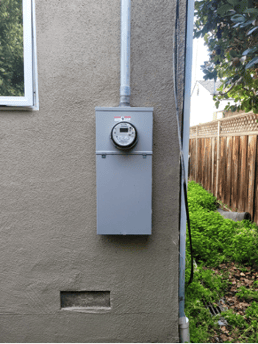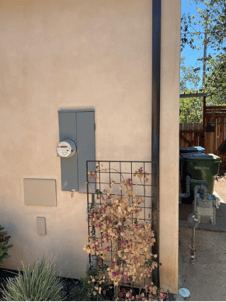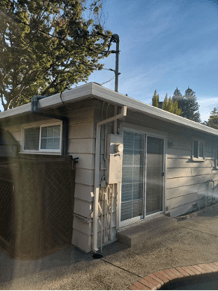Thanks to Brad Heavner, policy director at the California Solar & Storage Association (CALSSA), for his input into this article.
You’re getting proposals to add solar energy to your house, excited to reduce your electric bills, save money, and do your share to fight climate change. Then, that excitement fades, because you learn that your main electrical panel needs an upgrade to accommodate the additional back feed breaker needed for the solar system.
Your initial frustration is due to the unexpected cost to upgrade or replace the panel. But then you find out that because of PG&E policies, you may also have to relocate the main electrical panel outside of the utility’s so-called Hot Zone, throwing a wrench in the works and further upping the price substantially.
The solar professionals at Citadel Roofing & Solar are as frustrated as our customers at these requirements, which add time and money to the process of going solar.
But there are workarounds in many cases, and we’ve used them all to enable our customers to safely go solar. While it’s not our preferred claim to fame, Citadel can now add “Hot Zone expert” to our list of qualifications.
Let us take you through the four scenarios we and our customers encounter when it comes to main panel considerations, from easiest to most difficult. These are:
- No panel upgrade is needed.
- An upgrade is needed, but the panel is not in the Hot Zone.
- An upgrade is needed, the panel is in the Hot Zone, and you can meet the utility’s exceptions to keep the panel in the same location.
- An upgrade is needed, the panel is in the Hot Zone, you can’t meet the utility’s exceptions, and must relocate the panel when you upgrade it.
Background and Terminology
Main Panel: Chances are, your California home’s main electrical panel is part of a combo unit that also includes your electric utility meter (see photo). The tall gray box most likely installed on the exterior of your home contains the meter, which the utilities read monthly to gauge how much of their electricity you’ve used, and a row or two of circuit breakers controlling the flow of power to various loads in your home.
Homeowners sometimes call this main electrical panel the breaker box. It is referred to as a main service panel, or MSP, in the industry.
Circuits in the main panel feed electricity to different areas of your house. Amperes, or amps, describe how much electricity can flow through each circuit in your panel. An individual circuit might be 15 amps, or 30 amps. Bigger appliances are connected to 30-50 amp circuits. These are commonly designated “30A,” “40A,” etc.
The entire main panel also has an amperage rating. In California, most main panels are 100A, 125A, 200A, or 400A. This gives the amperage rating of the metal buss bar that feeds the circuit breakers.
Main Panel Upgrade: Adding a breaker for a solar energy system to your home’s main electrical panel may push the main panel over what it can handle. This can also be the case if you add other electricity needs, such as more appliances or an EV charger.
In these cases, a “main panel upgrade” or MPU is needed.
Some 15-20% of the homes Citadel Roofing & Solar assesses for solar energy require an MPU. It is more commonly the case in older homes.
It’s best for the homeowner (easier, faster and cheaper) to replace your main electrical panel in the same location as the current panel. But that’s not as simple as it sounds, hence the need for this article!
What is the Hot Zone?
The “Hot Zone” is what Citadel calls the immediate area around its gas meters. It is also called the radial clearance zone, gas clearance zone and exclusion zone. For years, the utility allowed the main electrical panels in California homes to be installed next to or near gas meters in this zone.
A few years ago, after being held liable for wildfires or “climate fires”, PG&E changed some of its policies to minimize its liability for future catastrophes. This included the requirement that a home’s main electrical panel no longer be allowed in the Hot Zone.
(For the record, at Citadel we believe any safety risks from the gas meter and main electrical panel being located near each other is extremely low when standard safety protocols are followed. While it is obviously not a good idea to mix gas and electricity, this particular set-up would not have been allowed, and in fact used by the utilities for decades, if it were unsafe.)
PG&E prescribes a number of measurements to dictate where the electrical panel can go, but the most important one states that the main electrical panel cannot be within 36 inches of the gas meter.
This put a stop to many solar projects, when the extra cost to relocate the electrical panel (or relocate the gas meter) was prohibitive for homeowners.
Then, in late 2022, PG&E introduced some exceptions to the ban on electrical panels in the Hot Zone. Instead of saying, “No, you can’t do this” they now say, “You can sometimes do this, but you’ll have to jump through some hoops.” In other words, some homeowners can replace or upgrade their main electrical panel while keeping it in the same location. That is easier and costs significantly less than relocating the panel. But it doesn’t work for everyone.
Let us walk you through the different scenarios.
Scenario 1: No Panel Upgrade Needed
If your main electrical panel can handle the additional breaker needed for a solar, or solar plus storage, system, and it isn’t in the Hot Zone, then congratulations! No MPU is needed for you to go solar.
This is the case for over 75% of people who install solar on their homes in California, in our experience.
Scenario 2: Panel Upgrade Needed, Panel Not in the Hot Zone
This is the second-best scenario: Your home requires an MPU to accommodate your solar, and your main panel is not in PG&E’s Hot Zone.
Citadel Roofing & Solar performs many MPUs every year that go smoothly and have no real challenges. First, we apply to PG&E for permission to upgrade the main panel. Once approved, PG&E comes out and turns off power to the home in the morning; we remove the old panel and install the new one, and do the wiring work necessary to transfer over all of the electrical loads; local inspectors review and approve the work; and PG&E comes back to turn the power on.
No muss, no fuss, although there is of course a cost for the equipment and labor.
Scenario 3: Panel Upgrade Needed, Panel is in the Hot Zone, Exceptions Met
PG&E has introduced three situations in which they may allow licensed electricians (like those at Citadel) to replace the main panel, in the existing location in the Hot Zone, rather than relocate the panel outside of the Hot Zone. In a nod to safety, they allow this if the main panel is unsafe, damaged or defective.
 Some main electrical panels installed in California homes years ago have since been deemed fire risks. The main defective panel brands are Zinsco, Sylvania, Federal Pacific, and Bulldog. If you just keep using these main panels as they are, without adding new load or circuits, or replacing breakers, the fire risk is considered extremely low. This is why insurance companies don't force people with these main panels to replace them.
Some main electrical panels installed in California homes years ago have since been deemed fire risks. The main defective panel brands are Zinsco, Sylvania, Federal Pacific, and Bulldog. If you just keep using these main panels as they are, without adding new load or circuits, or replacing breakers, the fire risk is considered extremely low. This is why insurance companies don't force people with these main panels to replace them.
But, if any work is to be done on the panels, most building departments will require an MPU.
With that background, here are the three ways homeowners may be able to get PG&E’s permission to upgrade a main electrical panel while leaving it in its location in the Hot Zone.
#1 - Your solar installer can prove the existing main electrical panel is damaged, by sending photos of the damaged components to PG&E. Damage might mean failed, melted or burned parts. This is rare, however. More commonly, Citadel can sometimes show that the panel includes a component on a product recall list.
#2 - The homeowner can provide PG&E with a letter from their homeowner’s insurance company recommending or requiring that the main electrical panel be replaced because it presents a hazard or is defective. A number of Citadel customers have contacted their insurance companies and had success with this approach.
#3 - The local building department provides a letter to PG&E stating that the main electrical panel requires replacement for safety reasons, usually because the existing equipment no longer meets UL electrical standards. Citadel maintains a list of more than one-hundred California building departments and can help the homeowner identify if this path makes sense in their city or town.
Replacing or upgrading main electrical panels in the Hot Zone in order to go solar has become complicated, due to PG&E’s new rules. But it’s worth trying to get the utility’s approval to keep the electrical panel in the same location, through one of the three measures listed above, because it is easier and therefore costs less.
Scenario 4: Panel Upgrade Needed, Panel is in the Hot Zone, Exceptions Not Met
If you can’t meet one of those three requirements and your main electrical panel is in the Hot Zone, our crews may have one other creative option: we’ll tie the solar into a subpanel, if your home has one and it can accommodate the additional breaker, thus preventing the need for an MPU.
Or, instead of moving the electrical panel, your gas line could be relocated outside of the Hot Zone (but we have not found PG&E very receptive to this option.)
But in most cases, homeowners are left with only one option: to relocate your main panel outside of the Hot Zone. This is no easy task. It’s complex, messy and expensive.
It is not as simple as picking a new spot, screwing the main panel to the wall and making a few connections. The original location for these panels was chosen because it’s the ideal spot. Finding another ideal spot, once a house is built and buttoned up, is harder than you might think.
Our goal is to move the main electrical panel a few feet to the left or right, keeping it in the same general area, as obviously this is easier and less expensive. But sometimes PG&E’s clearance guidelines prohibit that.
Many panel relocation projects require an extended search for the best route to run new wires. This may mean opening up an exterior or interior wall—not a prospect homeowners relish. It may mean fishing wires through crawl spaces—not something our crews relish.
And relocating the main panel means relocating all of the wires that connect the panel to your home’s electrical circuits. This is no small task if the relocation is nearby; if the relocation is some distance away, this becomes a huge undertaking.
Once a new location is identified, things proceed in one of two ways, depending on whether PG&E’s electricity feed reaches your house via overhead or underground lines.
Overhead: Main electrical panel relocations at homes connected to the PG&E grid via an overhead feed are more easily managed than those connected via underground wiring.
After installing the new main panel, and the associated wiring from the panel to your home’s internal loads, the new panel must be wired to the “weatherhead” on the side of your house or the roof—where the wires run from your home to the PG&E utility poles on the street.
Sometimes running overhead wires from your home to the street means crossing a neighbor’s yard—yet another complication.
Underground: For homes connected to the grid via underground feed, moving the main electrical panel comes with additional complications. You’ll need to have a contractor dig trenching and lay conduit and wiring to connect your home to PG&E equipment at the street. Add in the cost to manage inspections and interconnection, and this can run $10,000 to $30,000—roughly three times the cost of an overhead line connection.
Finding Solutions
Hot Zone issues are not black-and-white or cut-and-dry. Addressing them is a complex process requiring in-depth knowledge of electricity and construction. Citadel does everything in our power to find workarounds that help homeowners install solar without paying PG&E thousands of dollars. But sadly, sometimes it just doesn’t work.
The three exceptions that allow you to upgrade your main panel in its existing Hot Zone location help. But in the end, whether the savings and environmental benefits of solar energy are worth the extra cost to relocate your main electrical panel is a personal decision each homeowner must make. You can trust Citadel to guide you through your options.
If you’re like many California homeowners, you’ll find the MPU worth it: It allows you to enjoy the savings, energy independence, and increased property values that solar energy brings. And the Investment Tax Credit for residential solar systems may offset some of the MPU cost.



